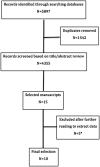European Stroke Organisation (ESO) guidelines on glycaemia management in acute stroke
- PMID: 31008333
- PMCID: PMC6453240
- DOI: 10.1177/2396987317742065
European Stroke Organisation (ESO) guidelines on glycaemia management in acute stroke
Abstract
Background: Hyperglycaemia is a frequent complication in acute stroke that has been shown to be independently associated with larger infarct size, haematoma growth, poor clinical outcome and mortality. This Guideline Document presents the European Stroke Organisation (ESO) Guidelines for the management of blood glucose levels in patients with acute ischemic or haemorrhagic stroke.
Methods: The working group identified related questions and developed its recommendations based on evidence from randomised controlled trials following the standard operating procedure of the ESO. This Guideline Document was reviewed and approved by the European Stroke Organisation Guidelines Committee and the European Stroke Organisation Executive Committee.
Results: We found low-quality evidence from clinical trials in ischemic or haemorrhagic stroke exploring the use of intravenous insulin aimed to achieve a tight glycaemic control with different glucose level targets and several other sources of heterogeneity. None of these trials neither the meta-analysis of them have demonstrated any significant benefit of tight glycaemic control with intravenous insulin in acute ischemic or haemorrhagic stroke patients on functional outcome or in survival and they have shown an increased risk for hypoglycaemia.
Conclusions: We suggest against the routine use of tight glycaemic control with intravenous insulin as a means to improve outcomes. The currently available data about the management of glycaemia in patients with acute stroke are limited and the strengths of the recommendations are therefore weak. Nevertheless, this does not prevent that hyperglycaemia in acute stroke patients could be treated as any other hospitalised patient.
Keywords: Acute stroke; European Stroke Organisation; GRADE; guidelines; hyperglycaemia.
Conflict of interest statement
The author(s) declared no potential conflicts of interest with respect to the research, authorship, and/or publication of this article.
Figures



Similar articles
-
European Stroke Organisation (ESO) guidelines for the management of temperature in patients with acute ischemic stroke.Int J Stroke. 2015 Aug;10(6):941-9. doi: 10.1111/ijs.12579. Epub 2015 Jul 6. Int J Stroke. 2015. PMID: 26148223
-
European Stroke Organisation (ESO)- European Society for Minimally Invasive Neurological Therapy (ESMINT) guidelines on mechanical thrombectomy in acute ischemic stroke.J Neurointerv Surg. 2019 Jun;11(6):535-538. doi: 10.1136/neurintsurg-2018-014568. J Neurointerv Surg. 2019. PMID: 31152058
-
European Stroke Organisation (ESO) guidelines on intravenous thrombolysis for acute ischaemic stroke.Eur Stroke J. 2021 Mar;6(1):I-LXII. doi: 10.1177/2396987321989865. Epub 2021 Feb 19. Eur Stroke J. 2021. PMID: 33817340 Free PMC article.
-
Mechanical thrombectomy in acute ischemic stroke: Consensus statement by ESO-Karolinska Stroke Update 2014/2015, supported by ESO, ESMINT, ESNR and EAN.Int J Stroke. 2016 Jan;11(1):134-47. doi: 10.1177/1747493015609778. Int J Stroke. 2016. PMID: 26763029
-
Managing post stroke hyperglycaemia: moderate glycaemic control is better? An update.EXCLI J. 2014 Aug 13;13:825-33. eCollection 2014. EXCLI J. 2014. PMID: 26417305 Free PMC article. Review.
Cited by
-
Cerebral Autoregulation in Ischemic Stroke: From Pathophysiology to Clinical Concepts.Brain Sci. 2021 Apr 16;11(4):511. doi: 10.3390/brainsci11040511. Brain Sci. 2021. PMID: 33923721 Free PMC article. Review.
-
Translation of nurse-initiated protocols to manage fever, hyperglycaemia and swallowing following stroke across Europe (QASC Europe): A pre-test/post-test implementation study.Eur Stroke J. 2023 Mar;8(1):132-147. doi: 10.1177/23969873221126027. Epub 2022 Oct 24. Eur Stroke J. 2023. PMID: 37021183 Free PMC article.
-
Impact of glycemic treatment and blood glucose monitoring on outcomes in patients with acute ischemic stroke without prior diabetes: a longitudinal cohort study.Diabetol Metab Syndr. 2024 Dec 19;16(1):302. doi: 10.1186/s13098-024-01542-2. Diabetol Metab Syndr. 2024. PMID: 39696458 Free PMC article.
-
Stress-Induced Hyperglycemia Predicts Poor Outcomes in Primary Intracerebral Hemorrhage Patients.NeuroSci. 2025 Feb 2;6(1):12. doi: 10.3390/neurosci6010012. NeuroSci. 2025. PMID: 39982264 Free PMC article.
-
The Prognostic Significance of Early Glycemic Profile in Acute Ischemic Stroke Depends on Stroke Subtype.J Clin Med. 2023 Feb 23;12(5):1794. doi: 10.3390/jcm12051794. J Clin Med. 2023. PMID: 36902581 Free PMC article.
References
-
- Scott JF, Robinson GM, French JM, et al. Prevalence of admission hyperglycaemia across clinical subtypes of acute stroke. Lancet 1999; 353: 376–377. - PubMed
-
- Luitse MJ, Biessels GJ, Rutten GE, et al. Diabetes, hyperglycaemia, and acute ischaemic stroke. Lancet Neurol 2012; 11: 261–271. - PubMed
-
- Piironen K, Putaala J, Rosso C, et al. Glucose and acute stroke: evidence for an interlude. Stroke 2012; 43: 898–902. - PubMed
-
- Els T, Klisch J, Orszagh M, et al. Hyperglycemia in patients with focal cerebral ischemia after intravenous thrombolysis: influence on clinical outcome and infarct size. Cerebrovasc Dis 2002; 13: 89–94. - PubMed
LinkOut - more resources
Full Text Sources

